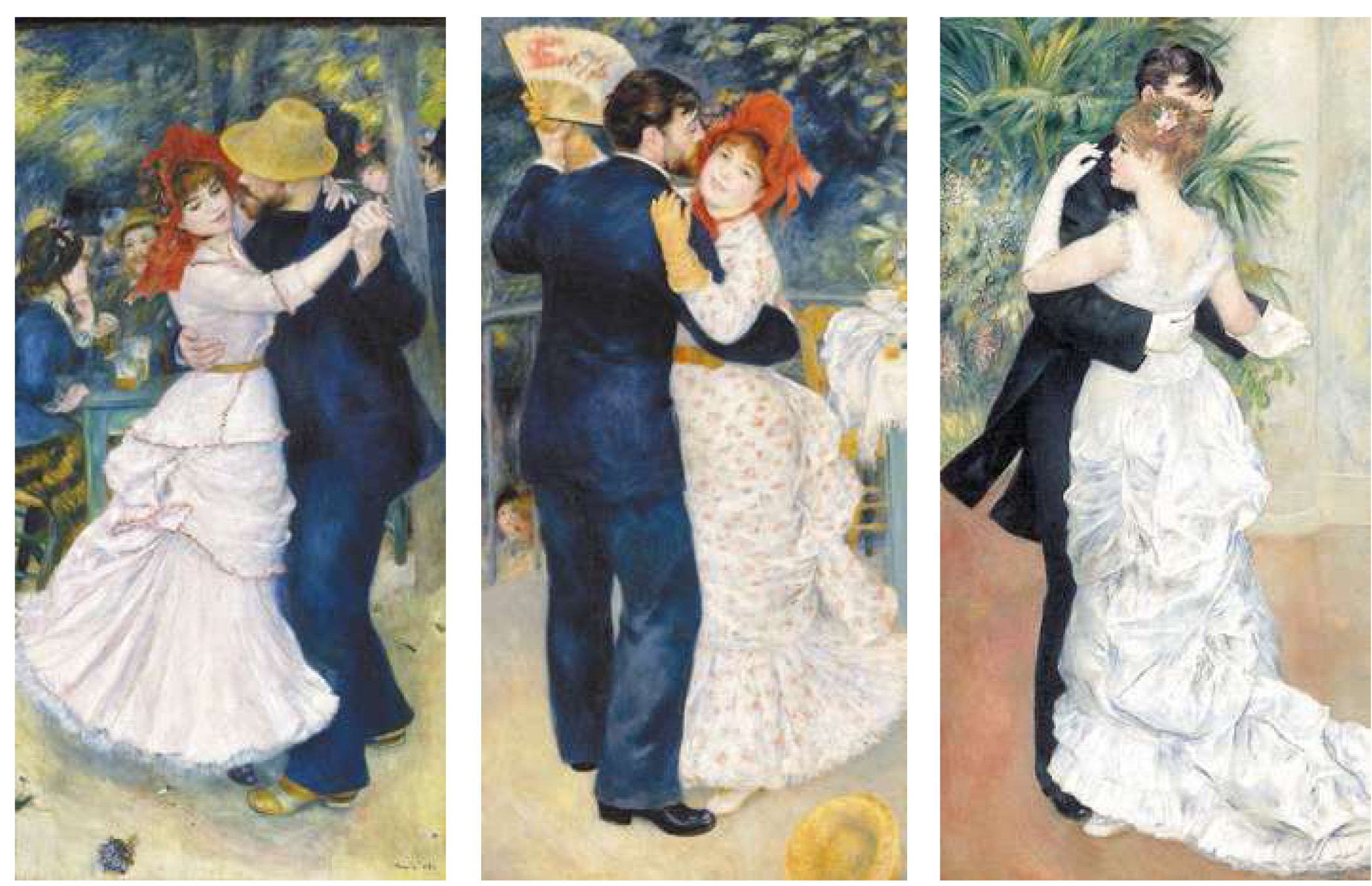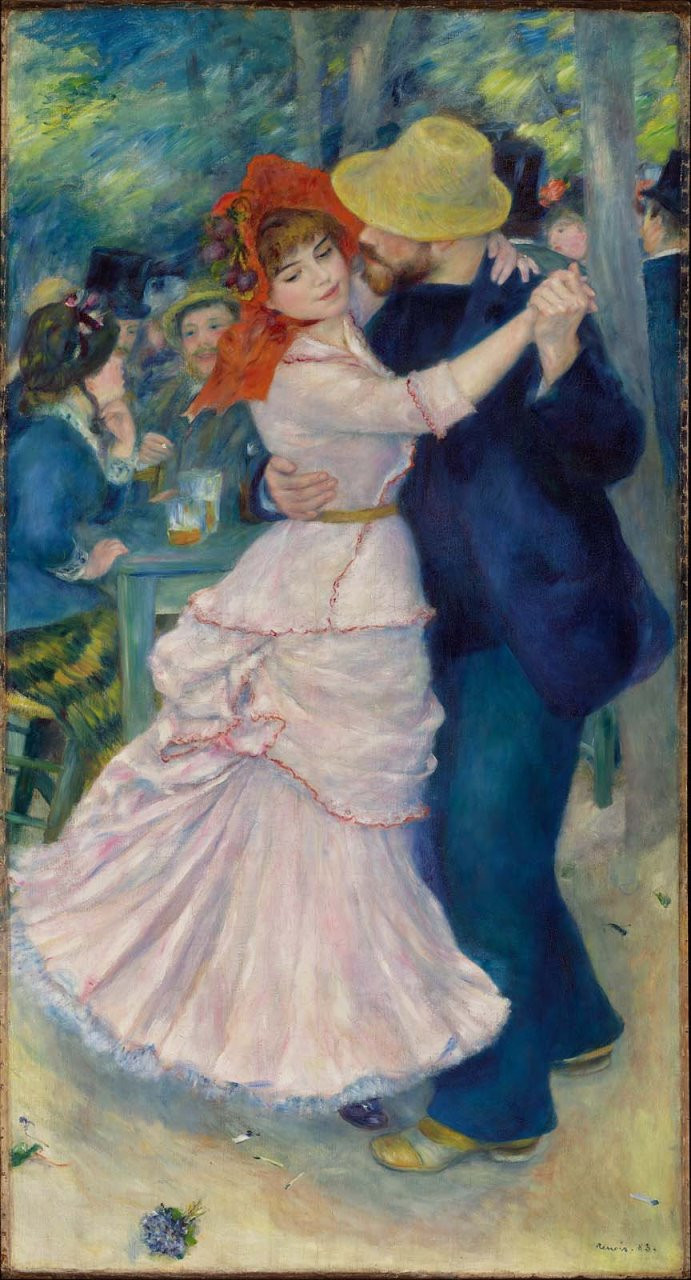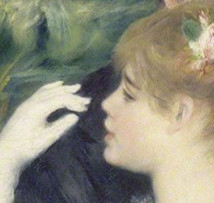Pierre-Auguste Renoir, a master of Impressionism, captured fleeting moments of life with vibrant brushstrokes and an unparalleled eye for human emotion. While his entire oeuvre is celebrated, a trio of paintings dedicated to dance stands out, offering a fascinating study in contrasts and passions. Among these, “Dance in the Country” (also known as “Dance at Bougival”) is particularly compelling, inviting viewers into a world of rustic charm and simmering romance. This article delves into the heart of “Dance in the Country,” exploring its nuances and comparing it to Renoir’s other dance works to reveal the depth of emotion he captured on canvas.
The Dance Triptych: Country, City, and Bougival
In 1883, Renoir painted three scenes of dance: “Dance in the Country,” “Dance in the City,” and “Dance at Bougival.” These were not just depictions of social events; they were explorations of human relationships as seen through the lens of dance. Rarely exhibited together, these paintings offer a unique opportunity to understand Renoir’s commentary on societal norms and personal desires. Paul Durand-Ruel, the art dealer instrumental in popularizing Impressionism, recognized the significance of these works, but their dispersal into different collections has often obscured the powerful dialogue they create when viewed in relation to each other.
 Dance at Bougival, 1883(Museum of Fine Arts, Boston. Photograph © Museum of Fine Arts, Boston)
Dance at Bougival, 1883(Museum of Fine Arts, Boston. Photograph © Museum of Fine Arts, Boston)
Image: Pierre-Auguste Renoir’s “Dance at Bougival,” 1883, showcasing the dynamic movement and intimate interaction of a couple dancing in a country setting.
The initial impression when comparing “Dance in the Country” and “Dance in the City” is one of stark contrast. The country dance brims with a lively, almost unrestrained energy. Men are depicted without formal gloves, and women in less restrictive attire. The setting is outdoors, amidst lush greenery, suggesting a natural, uninhibited atmosphere. In contrast, “Dance in the City” presents a more formal ballroom setting, characterized by somber columns, potted plants, and a sense of controlled movement. The ballroom scene, at first glance, seems subdued compared to its country counterpart. However, a closer examination reveals that both scenes, and especially “Dance in the Country,” are rich with complex emotions and narratives.
“Dance in the Country”: Decoding the Dynamics of a Rustic Romance
Focusing on “Dance in the Country,” we are immediately drawn to the central couple, seemingly caught in a spontaneous moment of dance. They appear to have just stepped onto the dance floor, leaving their table behind to join the festivities. The man’s firm grip on his partner’s hand suggests eagerness and perhaps a possessive air, yet the woman’s hold on her fan hints at an independent spirit. Intriguingly, she keeps her gloves on, a subtle barrier in this otherwise intimate setting.
 Close-up detail of the couple in "Dance in the Country" highlighting the woman's dress and the man's hand.
Close-up detail of the couple in "Dance in the Country" highlighting the woman's dress and the man's hand.
Image: A detailed view of the central couple in Renoir’s “Dance in the Country,” emphasizing the interplay of touch and subtle resistance through gestures and clothing.
The man is clearly captivated, his dropped hat unnoticed in his passionate pursuit. His gaze is fixed on her face, his lips nearing her cheek. However, the woman presents a more ambiguous picture. While her upper body maintains a slight distance, her lower body tells a different story. Renoir masterfully paints her dress melding into the man’s suit, creating a visual Yin Yang, symbolizing a close connection. Subtle details, visible upon close inspection, reveal the intimacy. The faint blue reflection on her dress suggests minimal space between them, and the shaded edge of her dress indicates it is pressed against his leg. Despite this physical closeness, her hand rests lightly on his shoulder, not embracing him, and her eyes subtly glance towards the viewer, acknowledging an outside observer.
 Another close-up from "Dance in the Country," focusing on the woman's gaze and hand placement, suggesting awareness and controlled engagement.
Another close-up from "Dance in the Country," focusing on the woman's gaze and hand placement, suggesting awareness and controlled engagement.
Image: Detail of the woman’s face in “Dance in the Country,” capturing her direct gaze towards the viewer, hinting at a playful awareness and engagement beyond her dance partner.
This interplay suggests a flirtatious dynamic. The woman is aware of her allure, engaging both with her partner and with the implied observer, enjoying the attention and the delicate dance of attraction. It’s been noted that Aline Charigot, Renoir’s future wife, served as the model for this woman. Perhaps Renoir subtly captured a nuanced reality of courtship, where passion and playful restraint intertwine.
The Wilder Side of “Dance at Bougival”: Passion and Hesitation
Moving to the left couple in “Dance at Bougival,” the atmosphere shifts. This dance is more dramatic, even bordering on intense. Renoir often used backgrounds to reflect the character of his subjects, and here, the background is bustling, with more men than women, hinting at a slightly more assertive, perhaps even predatory, social dynamic.
 The left couple in "Dance at Bougival," highlighting the man's casual attire and the woman's line of sight.
The left couple in "Dance at Bougival," highlighting the man's casual attire and the woman's line of sight.
Image: Renoir’s “Dance at Bougival” focusing on the left couple, illustrating the contrast in their postures and suggesting a more dramatic interaction.
The man’s attire is strikingly casual compared to the more formally dressed gentleman in “Dance in the Country.” His loose clothing and somewhat disheveled appearance project a wilder persona, suggesting a disregard for social conventions, or perhaps even a sense of dominance. His hold on the woman is also different. While in “Dance in the Country,” there was separation above and union below, here, the positions are reversed.
 Dance at Bougival, 1883 Pierre Auguste Renoir, French, 1841 – 1919 Oil on canvas, 71 5/8 x 38 5/8 inches (181.8 x 98.1 cm) *Museum of Fine Arts, Boston. Picture Fund, 37.375 *Photograph © Museum of Fine Arts, Boston 25missing
Dance at Bougival, 1883 Pierre Auguste Renoir, French, 1841 – 1919 Oil on canvas, 71 5/8 x 38 5/8 inches (181.8 x 98.1 cm) *Museum of Fine Arts, Boston. Picture Fund, 37.375 *Photograph © Museum of Fine Arts, Boston 25missing
Image: Full view of Renoir’s “Dance at Bougival,” showcasing the dynamic composition and the different interactions between the two couples depicted.
There’s passion in the upper part of their bodies – his neck cranes towards her, and despite her averted gaze, possibly avoiding a forced kiss, her arm is draped around his neck. Yet, their lower bodies are distanced. Instead of the subtle blue line of connection, there’s a blue blur indicating motion, clear lines of separation, and blue reflections suggesting distance.
 Detail showing the "blue blur" in "Dance at Bougival," symbolizing motion and distance between the couple.
Detail showing the "blue blur" in "Dance at Bougival," symbolizing motion and distance between the couple.
Image: A close detail from “Dance at Bougival,” highlighting the brushwork and use of blue to convey motion and a sense of emotional distance between the dancing figures.
The woman’s gaze offers a crucial insight. Her line of sight leads directly to a discarded flower on the floor. This fallen flower, the same color as the man’s attire, becomes a potent symbol – a metaphor for something used, discarded, and past its prime. Is she wary of this man? Does the flower represent a cautionary tale of fleeting romance? The ring on her finger, noticed by some observers, further complicates the narrative. Is she engaged to someone else? Her hesitation seems palpable, a push and pull between desire and caution.
“Dance in the City”: Restrained Formality, Underlying Yearning
In contrast to the country dances, “Dance in the City” initially appears devoid of such overt passion. The formal setting, the limited view of the man, and the overall composure suggest a more restrained atmosphere.
 Partial view of the man in "Dance in the City," showing his formal attire and posture.
Partial view of the man in "Dance in the City," showing his formal attire and posture.
Image: Detail of the man from Renoir’s “Dance in the City,” emphasizing the formality of his attire and reserved demeanor.
However, Renoir subtly reveals the underlying emotions of the woman. A playful shadow cast by her hand, resembling parted lips, hints at a hidden desire.
 Shadow detail from "Dance in the City," suggesting a hidden yearning and dream of a kiss.
Shadow detail from "Dance in the City," suggesting a hidden yearning and dream of a kiss.
Image: Close-up detail from “Dance in the City,” focusing on the shadow play of the woman’s hand, interpreted as a subtle symbol of longing and suppressed desire.
Her slightly parted lips and the “blush” implied by the shadow suggest a yearning for a kiss, a dream simmering beneath the surface of societal decorum. Her dress, seemingly endless and flowing upwards, could be interpreted as a metaphor for “passionate innocence,” rising towards the man, despite the formal constraints of their environment.
Conclusion: Stepping into Renoir’s World of Dance
Renoir’s dance paintings, particularly “Dance in the Country,” are more than just pretty scenes; they are insightful explorations of human interaction, desire, and social dynamics. “Dance in the Country” invites us into a vibrant, rustic world where romance is both playful and passionate, while “Dance at Bougival” reveals a more dramatic and hesitant encounter, and “Dance in the City” hints at restrained desires beneath a veneer of formality. Renoir’s life-size canvases encourage viewers to become participants, to step into these scenes and construct their own narratives from the glimpses of stories he so masterfully painted. Returning to these paintings, especially seeing them together, offers a rich and rewarding experience, revealing new layers of meaning with each viewing, much like the surprising reactions in a school chemistry lab, but with far more enduring beauty and emotional depth.
Image: Pierre-Auguste Renoir at work, capturing a moment of artistic creation, reflecting the dedication behind his masterpieces.
